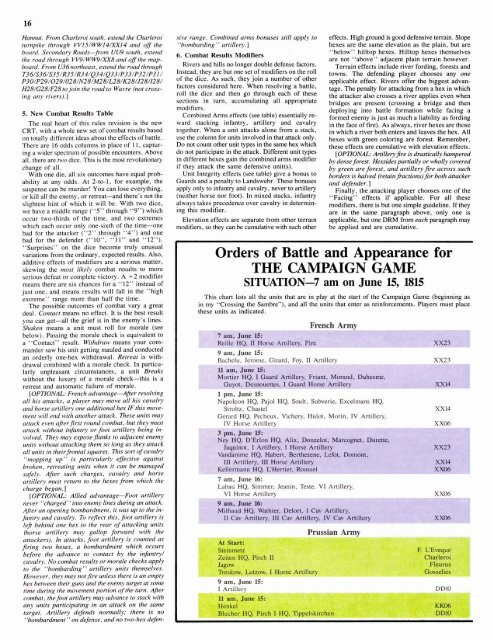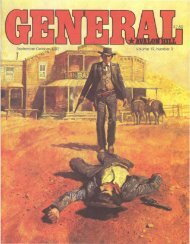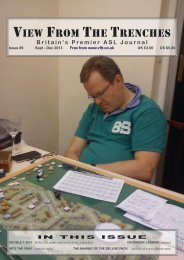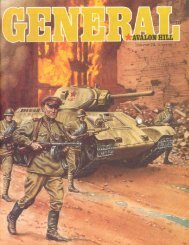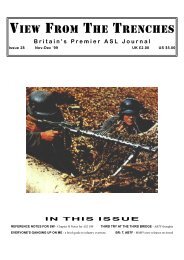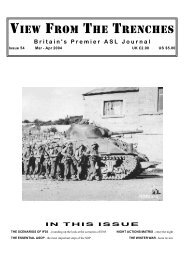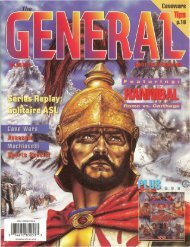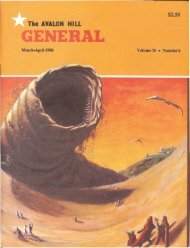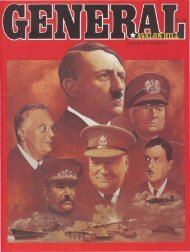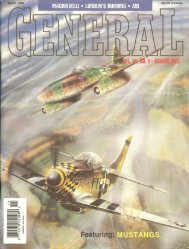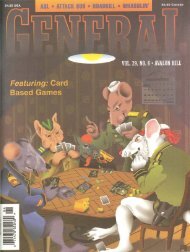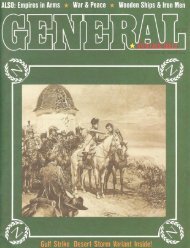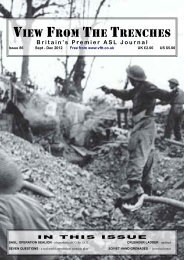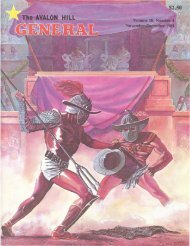18.64MB - View From The Trenches
18.64MB - View From The Trenches
18.64MB - View From The Trenches
- TAGS
- trenches
- www.vftt.co.uk
You also want an ePaper? Increase the reach of your titles
YUMPU automatically turns print PDFs into web optimized ePapers that Google loves.
Hannur. <strong>From</strong> Charleroi south, extend the Charleroi<br />
turnpike through VVl5/WW14/XX14 and off the<br />
board. Secondary Roads-from UU9 south, extend<br />
the road through VV9/WW9/XX8 and off the map-<br />
board. <strong>From</strong> U36 norrheast, extend the road through<br />
H28/G28/F28 to join the road to Wavre (not cross-<br />
ing any rivers).]<br />
5. New Combat Results Table<br />
<strong>The</strong> real heart of this rules revision is the new<br />
CRT, with a whole new set of combat results based<br />
on totally different ideas about the effects of battle.<br />
<strong>The</strong>re are 16 odds columns in place of 11, captur-<br />
ing a wider spectrum of possible encounters. Above<br />
all, there are two dice. This is the most revolutionary<br />
change of all.<br />
With one die, all six outcomes have equal prob-<br />
ability at any odds. At 2-to-1, for example, the<br />
suspense can be murder! You can lose everything,<br />
or kill all the enemy, or retreat-and there's not the<br />
slightest hint of which it will be. With two dice,<br />
we have a middle range ("5" through "9") which<br />
occur two-thirds of the time, and two extremes<br />
which each occur only one-sixth of the time-one<br />
bad for the attacker ("2" through "4") and one<br />
bad for the defender ("lo", "11" and "12").<br />
"Surprises" on the dice become truly unusual<br />
variations from the ordinary, expected results. Also,<br />
additive effects of modifiers are a serious matter,<br />
skewing the most likely combat results to more<br />
serious defeat or complete victory. A +2 modifier<br />
means there are six chances for a "12" instead of<br />
just one, and means results will fall in the "high<br />
extreme" range more than half the time.<br />
<strong>The</strong> possible outcomes of combat vary a great<br />
deal. Contact means no effect. It is the best result<br />
you can get-all the grief is in the enemy's lines.<br />
Shaken means a unit must roll for morale (see<br />
below). Passing the morale check is equivalent to<br />
a "Contact" result. Withdraw means your com-<br />
mander saw his unit getting mauled and conducted<br />
an orderly one-hex withdrawal. Retreat is with-<br />
drawal combined with a morale check. In particu-<br />
larly unpleasant circumstances, a unit Breaks<br />
without the luxury of a morale check-this is a<br />
retreat and automatic failure of morale.<br />
[OPTIONAL: French advantage-After resolving<br />
all his artacks, a player may move all his cavalry<br />
and horse artillery one additional hex IF this move-<br />
ment will end with another attack. <strong>The</strong>se units may<br />
attack even after first round combat, but they must<br />
attack without infantry or foot artillery being in-<br />
volved. <strong>The</strong>y may exposeJanks to adjacent enemy<br />
units without attacking them so long as they attack<br />
all units in theirfrontal squares. This sort of cavalry<br />
"mopping up" is particularly effective .against<br />
broken, retreating units when it can be managed<br />
safely. After such charges, cavalry and horse<br />
artillery must return to the hexes from which the<br />
charge began.]<br />
[OPTIONAL: Allied advantage-Foot artillery<br />
never "charged" into enemy lines during an attack.<br />
After an opening bombardment, it was up to the in-<br />
fantry and cavalry. To reflect this, foot artillery is<br />
left behind one hex to the rear of attacking units<br />
(horse artillery may gallop forward with the<br />
attackers). In attacks, foot artillery is counted as<br />
firing two hexes, a bombardment which occurs<br />
before the advance to contact by the infantry/<br />
cavalry. No combat results or morale checks apply<br />
to the "bombarding" artillery units themselves.<br />
However, they may not fire unless there is an empty<br />
hex between their guns and the enemy target at some<br />
time during the movement portion of the turn. After<br />
combat, the foot artillery may advance to stack with<br />
any units participating in an attack on the same<br />
target. Artillery defends normally; there is no<br />
"bombardment " on defense, and no two-hex defen-<br />
sive range. Combined arms bonuses still apply to<br />
"bombarding" artillery.]<br />
6. Combat Results Modifiers<br />
Rivers and hills no longer double defense factors.<br />
Instead, they are but one set of modifiers on the roll<br />
of the dice. As such, they join a number of other<br />
factors considered here. When resolving a battle,<br />
roll the dice and then go through each of these<br />
sections in turn, accumulating all appropriate<br />
modifiers.<br />
Combined Arms effects (see table) essentially re-<br />
ward stacking infantry, artillery and cavalry<br />
together. When a unit attacks alone from a stack,<br />
use the column for units involved in that attack only.<br />
Do not count other unit types in the same hex which<br />
do not participate in the attack. Different unit types<br />
in different hexes gain the combined arms modifier<br />
if they attack the same defensive unit(s).<br />
Unit Integrity effects (see table) give a bonus to<br />
Guards and a penalty to Landswehr. <strong>The</strong>se bonuses<br />
apply only to infantry and cavalry, never to artillery<br />
(neither horse nor foot). In mixed stacks, infantry<br />
always takes precedence over cavalry in determin-<br />
ing this modifier.<br />
Elevation effects are separate from other terrain<br />
modifiers, so they can be cumulative with such other<br />
effects. High ground is good defensive terrain. Slope<br />
hexes are the same elevation as the plain, but are<br />
"below" hilltop hexes. Hilltop hexes themselves<br />
are not "above" adjacent plain terrain however.<br />
Terrain effects include river fording, forests and<br />
towns. <strong>The</strong> defending player chooses any one<br />
applicable effect. Rivers offer the biggest advan-<br />
tage. <strong>The</strong> penalty for attacking from a hex in which<br />
the attacker also crosses a river applies even when<br />
bridges are present (crossing a bridge and then<br />
deploying into battle formation while facing a<br />
formed enemy is just as much a liability as fording<br />
in the face of fire). As always, river hexes are those<br />
in which a river both enters and leaves the hex. All<br />
hexes with green coloring are forest. Remember,<br />
these effects are cumulative with elevation effects.<br />
[OPTIONAL: Artillery fire is drastically hampered<br />
by dense forest. Hexsides partially or wholly covered<br />
by green are forest, and artillery fire across such<br />
borders is halved (retain fractions) for both attacker<br />
and defender.]<br />
Finally, the attacking player chooses one of the<br />
"Facing" effects if applicable. For all these<br />
modifiers, there is but one simple guideline. If they<br />
are in the same paragraph above, only one is<br />
applicable, but one DRM from each paragraph may<br />
be applied and are cumulative.<br />
Orders of Battle and Appearance for<br />
THE CAMPAIGN GAME<br />
SITUATION-7 am on June 15, 1815<br />
This chart lists all the units that are in play at the start of the Campaign Game (beginning as<br />
in my "Crossing the Sambre"), and all the units that enter as reinforcements. Players must place<br />
these units as indicated.<br />
French Army<br />
Napoleon HQ, Pajol HQ, Soult, Subverie, Excelmans HQ,<br />
Stroltz, Chaste1 XX14<br />
Gerard HQ, Pecheux, Vichery, Hulot, Morin, IV Artillery,<br />
1 rmv I<br />
. . .. . . . -- .


